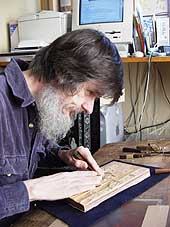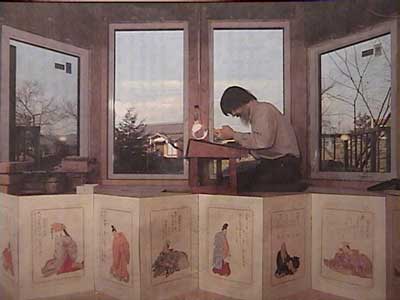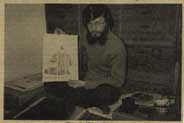In the wake of Hokusai
From behind his shaggy beard, affable British-born Canadian woodblock printmaker David Bull ended our interview at his studio in western Tokyo with what sounded like a challenge.
The Japanese-language media, he said, "would never write about the stuff I've told you today. Never. No way. They find words in the middle of what I've said to write the story that they wanted - that's what journalists do."
"Could The Japan Times do any better?" he seemed to be asking. Could we portray this present-day successor to those printmakers of the Edo Period (1603-1867) who made ukiyo-e ("floating world") artists such as Hiroshige and Hokusai famous, without resorting to convenient preconceptions?
Well, here goes.
 Preconception No. 1: David Bull mastered woodblock printmaking through years of patient study under a wise old sensei (teacher).
Preconception No. 1: David Bull mastered woodblock printmaking through years of patient study under a wise old sensei (teacher).
Bull: "Sitting at the feet of the master. No way! I'm as good as any guy. I'm not as experienced yet, but I'm as good as you are."
Bull's distaste for the traditional Japanese master-apprentice system - all-pervasive in the arts or almost any field of endeavor - does not mean he is a rogue. Woodblock printmaking, he explained, is different from other Japanese art forms because it has no master-apprentice system.
"There's no masters, no apprentices, no schools, no nothing. You know why? Because we make porn!" he said, before reminding me of the erotic shunga prints of the Edo Period.
Bull first encountered woodblock prints at an exhibition in around 1980 in Toronto, where he was managing a music store. Blown away by their "sculptural" quality (the way ridges and depressions are left in the paper after it has been printed on the wooden blocks), he set about experimenting with the technique himself.
Despite having had no formal art education, by 1986 Bull had become sufficiently hooked to relocate his family - Japanese wife and two young daughters - so he could study woodblock printmaking at source. Once in Japan and living outside Tokyo, he set up an English school in his house and practiced carving blocks and printing reproductions of famous prints in his spare time.
It took about a year before he decided he had a work worth showing to a native printmaker.
"I went to this demonstration and showed one of my prints to the printer. He was like, 'Where did you get this?' I said, I made it myself, and he was like, 'Ha, ha, ha. No, where did you get it?' "
Bull eventually got to know the printer and on a number of occasions received advice. But he was never an apprentice.
Preconception No. 2: Ukiyo-e is a dying art form and David Bull is valiantly preserving it.
Bull: "I'm not preserving a tradition. To try to preserve it artificially is meaningless, counterproductive, a waste of money, whatever."
What he does do is enjoy making woodblock prints - and he does it skillfully enough that people want to buy them. Since 1991, in fact, he has made a living from selling his prints to subscribers, and 75 people have so far subscribed to his current series of 12 original prints.
Bull compares it to classical music: "We still like playing Mozart symphonies. Do we do it because it's tradition? No. (It's) because guys like playing Mozart and people like listening to Mozart."
Last but not least is preconception No. 3, which is one that many foreigners are prone to have about the Japanese: Any foreign craftsman - even one as talented as David Bull - will never be fully admitted to the inner sanctum of native practitioners.
Bull himself suspected this was the case, recalling his own admission into the official woodblock printmakers association (Tokyo Mokuhanga Kogei Kumiai): "I thought at first that they were going to be secretive and I'd better not push. They might be antiforeign. But they were really open. 'Come on in!' they said. 'Me?' I asked, and they were like, 'Yeah, whatever, join the group!'"
TV Listings
The 'Woodblock Shimbun' has a full selection of TV programs on file. Videos available include some of David's news appearances, complete feature programs, and some short documentaries on his work. The files are in QuickTime format, and can be easily viewed with your browser.
Program listings are on the Index page ... ![]()
13 Another Lucky Number
 David Bull is as insistent as he is stubborn. No sooner has he sat me down beside his workbench (the only warm room in the house), with younger daughter Fumi (16) creating a Web page on the computer on top of the "kotatsu," than he is demanding how much I know about "hanga" (woodblock prints). "Hanga were never made to be framed and hung on walls," he states. "Premodern Japan had no such tradition. Prints were objects, not images, to be looked at in natural light. The best way for the art of the craftsman to be appreciated is in your hands, at a window." (2002)
David Bull is as insistent as he is stubborn. No sooner has he sat me down beside his workbench (the only warm room in the house), with younger daughter Fumi (16) creating a Web page on the computer on top of the "kotatsu," than he is demanding how much I know about "hanga" (woodblock prints). "Hanga were never made to be framed and hung on walls," he states. "Premodern Japan had no such tradition. Prints were objects, not images, to be looked at in natural light. The best way for the art of the craftsman to be appreciated is in your hands, at a window." (2002)
Full Story. ![]()
Woodblock craftsman combines old, new
Day after day, David Bull sits in his workroom almost all day long using his energy to make hanga or woodblock prints. His workroom, housed in his four-story house standing on the side of a riverbank in Ome, Tokyo, has yet to be completed because he is building the room himself by taking time from his busy production schedule. (2004)
Full Story. ![]()
Japan and Me
"In 1775 an Edo bookshop published a series of portraits of the Hyakunin Isshu poets with illustrations by Katsukawa Shunsho, who was the leading designer of his day, just before Utamaro. We do not know if the book sold well or not, but few copies have survived and the book is extremely rare." (1989)
Full Story. ![]()



